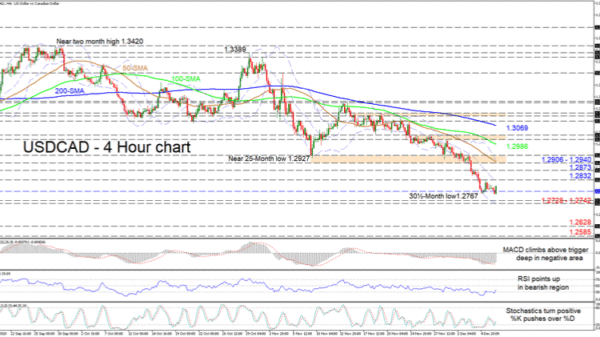USDCAD is trading around the 1.2782 trough, aggressively formed in October of 2018, which is freezing its negative price action, as it hits a 30½-month low of 1.2767. Nonetheless, the dictating simple moving averages (SMAs) are endorsing the predominant bearish direction.
However, currently the short-term oscillators are displaying strengthening positive momentum. The MACD, some distance below zero, is rising above its red trigger line, while the RSI is climbing above the 30 threshold. Furthermore, the stochastic oscillator %K line has completed a bullish overlap of the 20 mark and the %D line, promoting an upside retracement in price maybe towards the mid-Bollinger band or the 1.2873 high.
If buying interest intensifies, initial resistance may occur at the nearby high of 1.2832, where the mid-Bollinger band is currently located. Overcoming the mid-Bollinger band may then jump the pair towards the 1.2873 barrier. Gaining more ground the bulls may then face a tough resistance zone of 1.2906-1.2940, reinforced by the encapsulated 50-period SMA and upper Bollinger band. Conquering this too, buyers may then aim for the 100-period SMA at 1.2986.
On the flipside, if sellers retake the reins, and slide under the 1.2767 multi-month low, early downside constrictions may arise from the crucial support section of 1.2728-1.2742. Diving underneath this channel, which also contains the lower Bollinger band, the price may sink towards the 1.2628 and 1.2585 lows that had been achieved back in April of 2018.
Summarizing, USDCAD continues to maintain a solid bearish demeanour and a break below 1.2728 may reinforce this view. Yet, a shift in the loonie above the 200-period SMA and the 1.3177 high could hurt the broader negative outlook.















